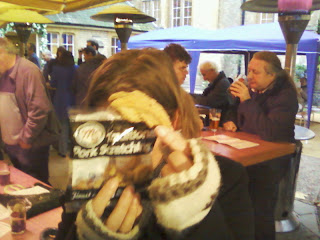On my recent tour of Botanix I got to see how to assess hops by hand.
The hops I use at work mainly come in whatever vacuum packs the suppliers choose to send me so assessing hops for quality is not something I normally do. Keen to make the most of the visit I' d done a bit of cramming before hand, reading the chapter on hops in the
Handbook of Brewing
. It always helps when you're trying to learn things if you've some idea what's going on in the first place. And it helps even more when you're trying to write up what you've seen!
We were shown sample of the British aroma hops
East Kent Goldings*. The samples come in neatly cut blocks extracted from hop pockets or bales and wrapped in thick blue paper. The block should first be gently pressed on the uncut side and have a slight springiness. A sample that's too hard could be over-pressed which causes the lupulin glands to rupture or it may have a high moisture content. Next looking at the cut side the lupulin can be seen, if the colour is too dark it can indicate drying at too high a temperature causing lower oil content and relatively poor storage ability.
The hops can be visually assessed for disease, though brown is not necessarily bad. I've heard a few people judge hops by how green they are, but I've not been totally convinced. For brewing it's the yellow lupulin glands, inside at the base of the cones, that we're after so 'leaf' (actually
bracts) colour isn't critical. Browning of the hops can be caused by wind damage, which is superficial and can be determined by looking at the cone and seeing if the browning is only partial or throughout the whole cone. Downy and Powdery Mildew will cause the whole cone to go brown, Powdery can cause the whole cone to be so stunted it's called a "rat's turd" and Downy can be even worse! Red spider mites can also cause hops to brown, and serious aphid infection will lead to parts of the cone going black as mould grows where the honeydew is excreted.
When the block is broken apart and cones removed they can be assessed for how easily they shatter. If they shatter easily the hops may have been harvested late but if the block already contains a lot of shattered hops they may have been over dried or subjected to rough handling after kilning. Easy shattering will not necessarily affect the brewing quality, and low alpha varieties are more prone to it as they have less lupulin to stick the cones together. Seeing an excessive amount of leaf and bine definitely is a problem as it shows poorly designed or operated picking machines were used.
Next the aroma of the hops can be assessed. Though hop aroma is variety dependent, and not directly related to the aroma they will give to beer, hop aromas can still be categorised as desirable (e.g. citrus, spice, floral, pine) or undesirable (e.g. musty, cheesy, rubbery). The cones can be sniffed as they are before rubbing them between the hands to release the aroma.
Hops can be placed into one of three categories:
choicest,
grade one and
grade two. Apparently the brewing quality of
grade one hops is as good as
choicest but I don't think we were told about what happens to grade two, though it was mentioned that ever the poorest hops can still be sent to the factory for extraction.
There are also a whole series of laboratory analyses that hops can be subjected to but I'll leave it there for now.
*That was how the sample was labelled so don't know if they were
Early Birds or
Cobbs or
Eastwells or what. It's not always a satisfying business being a beer nerd.


















